Some of the links in this post may be affiliate links.
Want to learn the basics of how to propagate Philodendron Pink Princess and easily make more of this super popular, always out-of-stock plant? It is easier than you think, and I will teach you 3 easy ways to propagate your Philodendron erubescens ‘Pink Princess’!
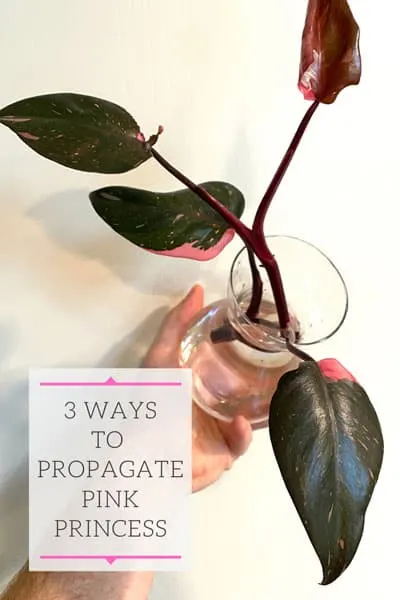
You may be familiar with some ways I’ll show you, but I will also explain an unusual propagation method to get the most out of your Pink Princess and easily start several new plants!
Table of Contents
PINK PRINCESS PROPAGATION BASICS
Before we go any further, let’s take a look at the basic anatomy of the plant so that you have a basic understanding of the plant and how to propagate.
Check out the photo below of a cutting I made:
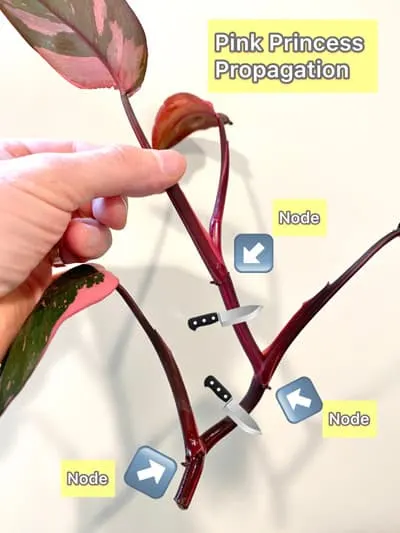
The area where each leaf meets the stem or vine is called a node. The node is where both roots and new growth will form.
You can see the aerial roots where the arrows are pointing. I could have taken this one cutting and made 3 separate cuttings if I wanted, but I wanted to have one nice plant because I raffled off this cutting for charity.
If I wanted to make multiple cuttings, I indicated where to cut with the knives in the photo.
At a minimum, you really just need one node to propagate.
Now let’s take a look at 3 various methods to root and propagate your plant.
PINK PRINCESS PROPAGATION METHODS
1. WATER PROPAGATION
Most of us are very familiar with this one, and it is very simple!
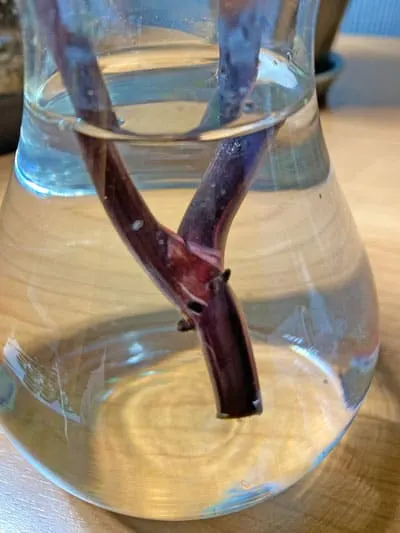
All you need to do is make sure you have one node (the part where the leaf meets the stem) under water, just like in the photo above.
You can see the aerial roots surrounding the node. After a few weeks or so, these roots will extend and grow in the water.
Make sure you have one or two leaves on each cutting.
You don’t need to wait long after the roots start growing before putting the cutting in soil. You can transfer to soil after the roots are maybe an inch long or so. A little shorter or longer won’t make a difference.
Just don’t wait forever!
When you pot up your cutting into soil, I like to use 3 parts of a good potting mix like Miracle Gro and I add 1 part perlite to make it nice and fluffy. This is a great overall potting mix for your leafy tropicals.
Or you can purchase the AMAZING potting mixes from Oh Happy Plants. Use either the Tropical Climber Soil Blend or the Rainforest Soil Mix, and if you use my links, you will automatically receive 10% off at checkout for any products.
Don’t use a huge pot when you’re potting up your cutting. A 4 inch diameter pot is plenty for one cutting.
And if you enjoy water propagation, you may want to look at my post on the best houseplants to water propagate.
2. SOIL PROPAGATION
Once you have your cutting, instead of putting it in a vase of water like I did above, you can choose to plant it directly into a pot that contains a soil mix instead. For rooting in soil, I’d recommend a mix that is half soil and half perlite and you will want the node buried under the soil.
This method will require a little bit more baby sitting. You’ll want to keep your potting mix fairly damp to encourage rooting. Don’t ever let it dry out, especially for long periods, or roots may never form.
And don’t worry about “overwatering.” Since half of your potting mix is perlite, it introduces a lot of air and oxygen so it is pretty hard to “overwater.” It is the lack of oxygen to the roots that causes root rot.
By adding enough perlite, we are able to maintain a moist medium that is needed for rooting, but it also helps to prevent rotting!
Increasing humidity is also helpful if you’re doing soil propagation. You might want to loosely place a clear plastic bag as a tent over the cutting, use a humidifier, or place on a tray of moist pebbles.
The final way to propagate Pink Princess and easily increase your collection by a lot is…
3. BARE STEM CUTTINGS
This method is fun, and will result in quite a few plants! You will generally get a new plant at every single node! This method uses segments of the stem and no leaves at all.
This method is ideal if you have bare areas of stem. Or even if you have leaves that look a bit ratty so you can start fresh.
I didn’t pay much attention to giving my plant a good support, so it grew with a really crooked stem.
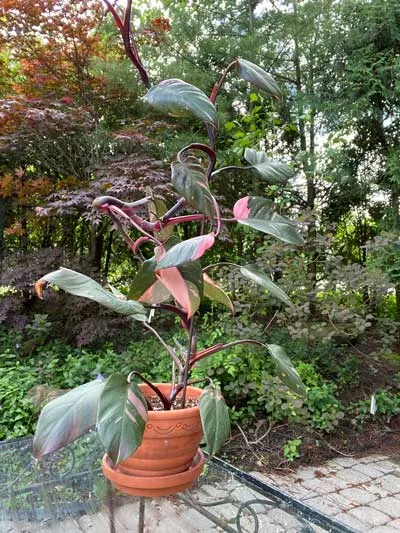
I decided to take advantage of this situation to propagate, and give the original plant the moss post that it deserved from the beginning.
I cut most of the plant off to propagate and gave my original plant a DIY moss pole. I made my own and I can’t believe I waited so long to do it! It was super easy and much better than anything commercially available.
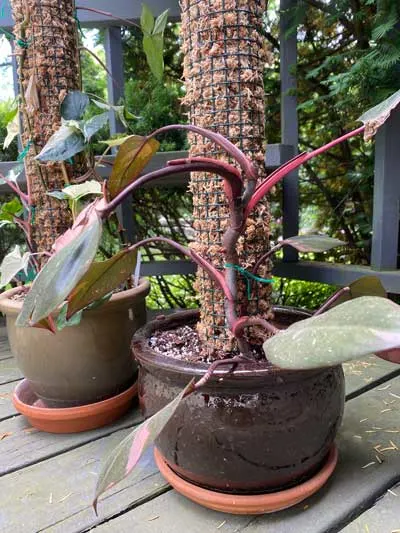
With the rest that I cut off, I water propagated the tip cutting I showed earlier in this post, and then used the rest of the stem for bare stem cuttings.
For this method, you want to use a container with a clear lid. Asian takeout containers are perfect for this!
Fill your container with a mixture of half potting soil and half perlite. Moisten the mixture but make sure you don’t have any water accumulated at the bottom.
You’re basically going to cut the stem on either side of each node and completely remove the leaves if you have any leaves. The segments I cut off were about 1 1/2 inches long or so.
Then place each stem cutting half buried in the soil mix as shown below.
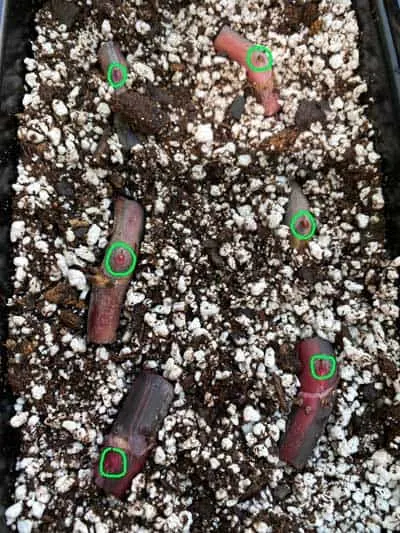
You’ll want to place the “eyes” facing up. I circled the eyes above. They will appear as a slightly raised pink area. You can see the eye a little more clearly in the photo below.
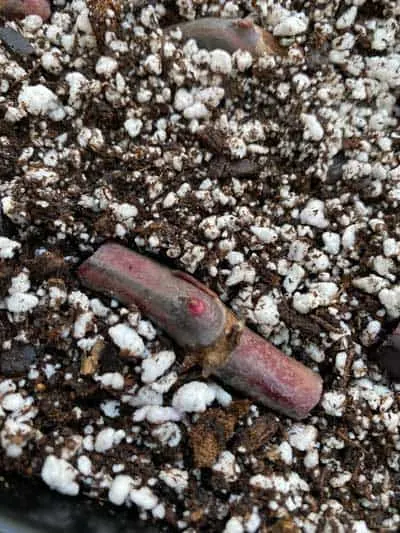
The “eye” is where the cutting will start to grow your new plant! Be sure to remove the leaf completely off the stem so that it exposes the eyes.
If you don’t see the eyes or aren’t sure, just place the stem cuttings in the soil mixture anyway. Nature will still figure it out!
When you have placed all your stem cuttings in the soil mixture, close the lid and place it in a bright area, but out of direct sun so you don’t cook your plants!
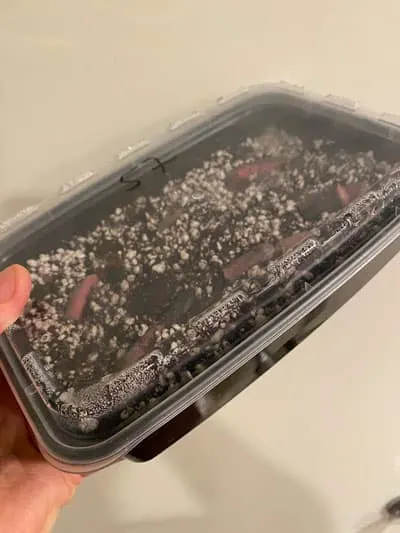
Be sure to only use containers with clear lids. You can also cover with clear plastic wrap if you don’t have these types of containers handy.
The clear lid lets light through, but also keeps the humidity high which is so helpful for propagation. Every so often, I remove the lid for a few minutes just to air things out.
After a few weeks, you should start to get some growth! You will have best success if you propagate this way during the Spring or Summer when plants are actively growing.
Here is one of the two containers after less than 2 months!
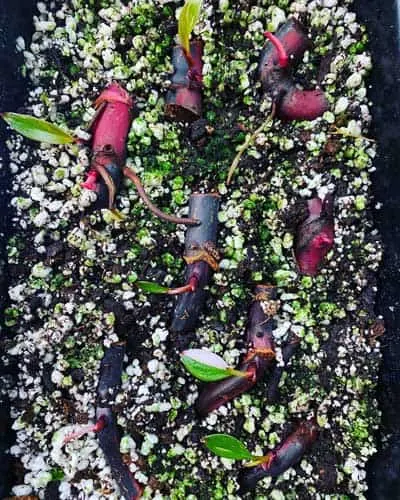
You will obviously have to remove the lid once growth starts to occur to allow for room. Be sure to keep the medium moist. Once the cuttings each have a leaf, you can transplant into its own pot.
After each stem cutting had at least a couple leaves, I went ahead and transplanted each into its own small pot. This time, I buried the original stem below the surface.
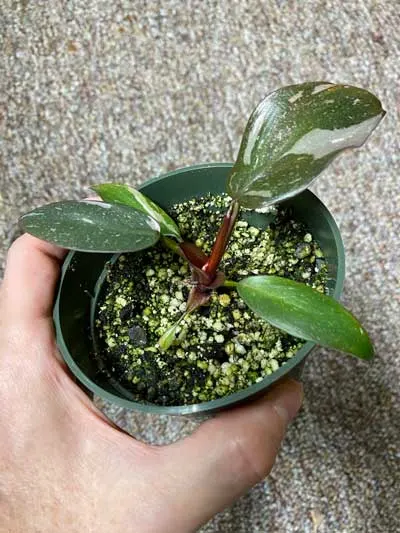
The fun part about this method is that you will have a lot of new plants and each one will be different. Not all will exhibit the same variegation, and you might just get the one gem that you’ve been looking for!
POTTING MIX VS. SPHAGNUM MOSS PROPAGATION
After I conducted the 3rd propagation method with bare stem cuttings in the takeout container, I made a few observations.
Once I removed the sprouted stem cuttings out of the take out container, I placed each one in a separate small pot. I placed some in a potting mix and perlite blend, and the rest is moist sphagnum moss. At this point, none of the cuttings had any root system yet, even though they all started to grow leaves.
I allowed them to grow for several weeks, and what I noticed though that the ones that I had moved into sphagnum moss went on to develop a beautiful root system, while the ones that I had moved into a potting mix STILL had no root system.
Take a look at the long, pink roots on this cutting that was growing in sphagnum moss. It grew quite a few roots and was quite vigorous!
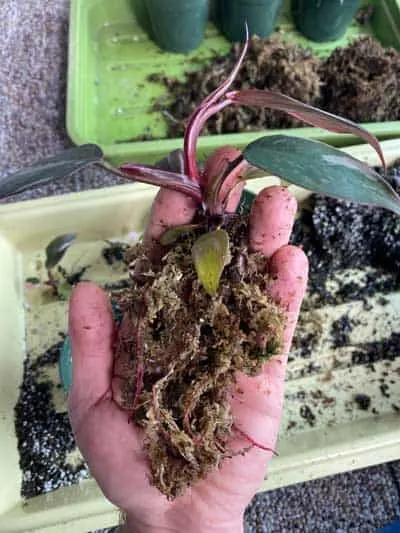
Now take a look at this cutting that was in the potting mix/perlite blend for a while. NO roots!
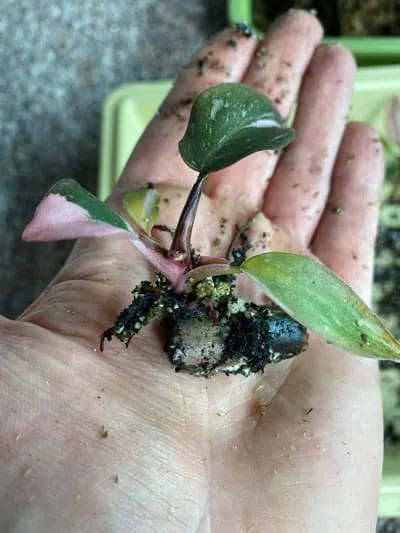
Every single one of the cuttings that I had transferred to sphagnum moss had developed a root system. NONE of the ones in potting mix/perlite had a root system. This led me to conclude, at least in this case, that propagation in sphagnum moss will lead to a superior root system development.
Once the ones growing in sphagnum moss grew a good root system, I transferred them to a pot with my normal potting mix (3 parts of miracle gro and 1 part perlite) to continue growing.
If I were to do this 3rd propagation method again , I would start all the bare stem cuttings in sphagnum moss from the start.
For any of the 3 Pink Princess propagation methods above, you may want to avoid doing this in the Winter to maximize success.
MORE RESOURCES
Be sure not to miss my other posts on Philodendron Pink Princess:
Philodendron Pink Princess: A Grower’s Guide
and


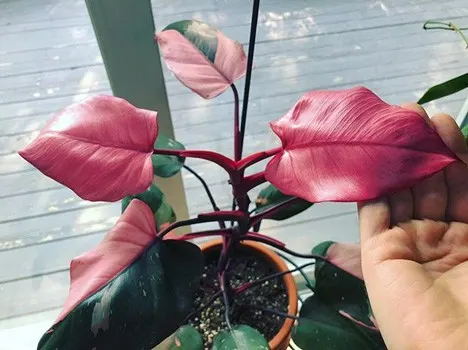
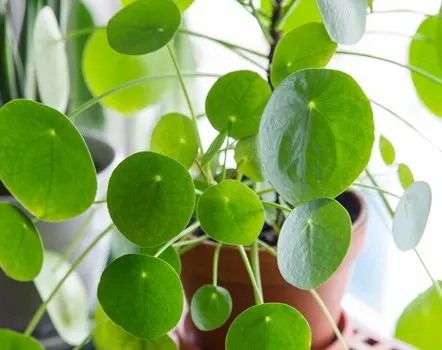
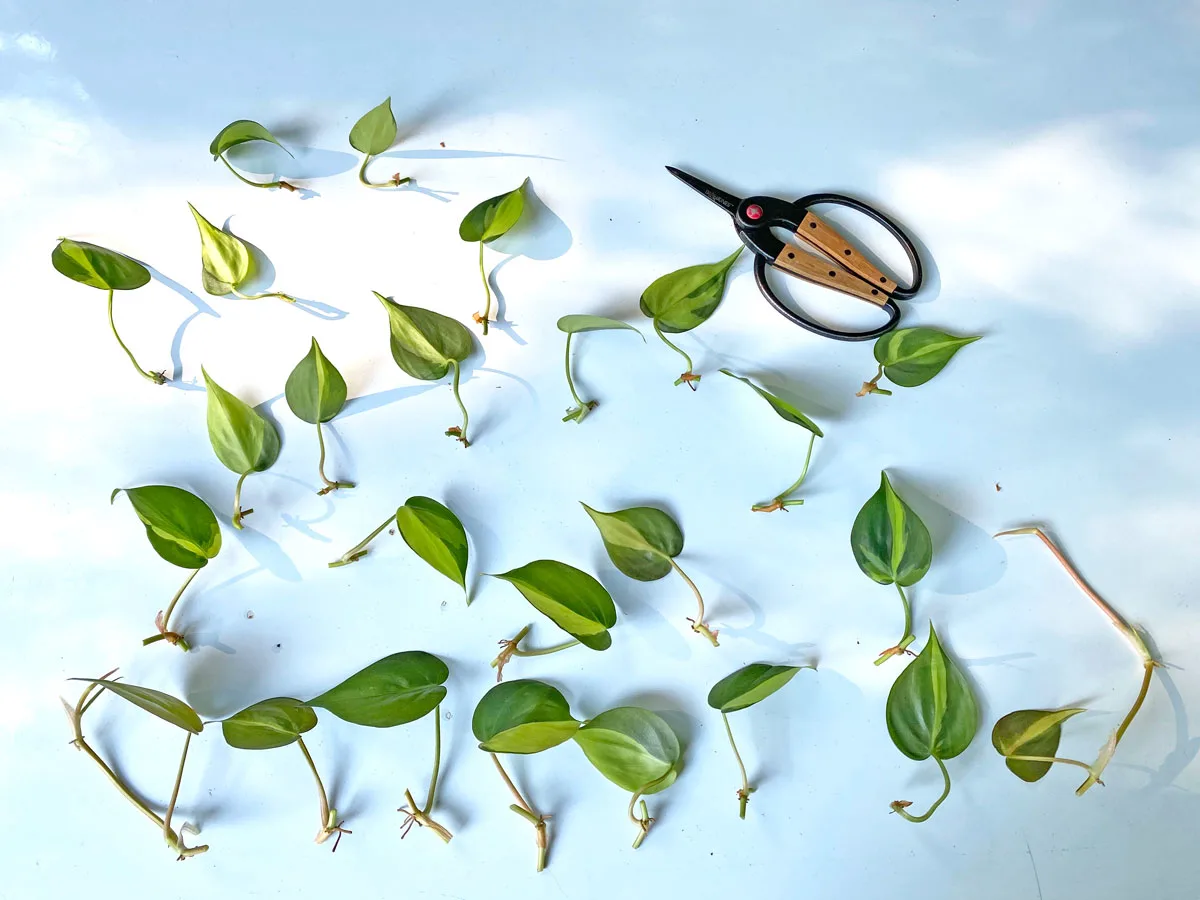
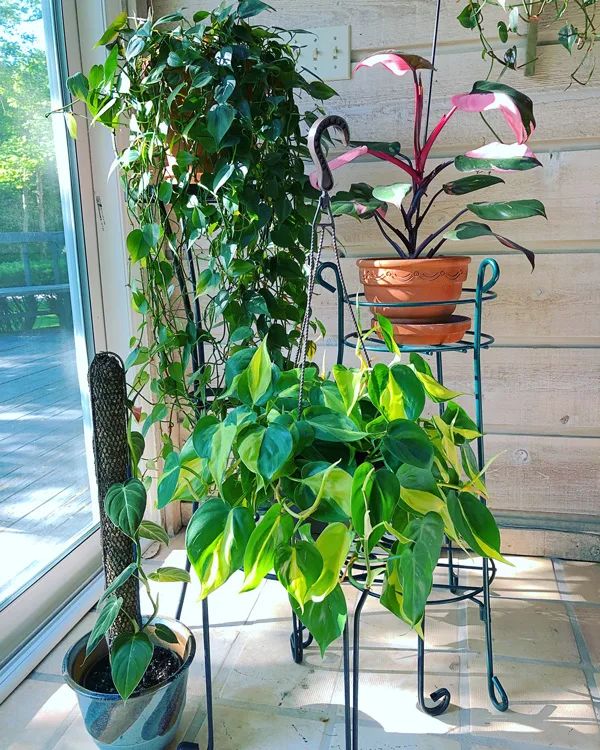
Tanya Smith
Wednesday 14th of May 2025
This was the best article I’ve read in a long time, and I’m always scouring the internet for plant tips and advice! Not only did this article give me the courage to chop and prop my PPP, but I also made your homemade moss pole… AMAZING!! Thank you so much for caring so much and providing excellent resources. I am so grateful I stumbled on your page. I’ve used so many links and have it bookmarked.
Raffaele Di Lallo
Thursday 15th of May 2025
You're very welcome Tanya! I'm so glad that you enjoyed these posts! And good luck with your propagations and other projects :-)
Stephanie
Tuesday 15th of October 2024
Thee best! Thee absolute best article/tutorial! EVER. I understood everything and every question was answered. Thank you!
Raffaele Di Lallo
Tuesday 15th of October 2024
Hi Stephanie! You're very welcome, and I'm so glad that you enjoyed my article!
Ivory
Wednesday 30th of August 2023
Hi, I have recently tried propagating my ppp and the ones in water propagation are pretty much dying and the ones in spagnum moss isn't doing better. Is there a way to save them still? does the water propagation method leads to the leaves slowly dying and dropping? How long will the roots starts to show for water propagation? And do you have a photo of how it looks like? because my ppp's aerial roots are all very long before i cut them.
Raffaele
Wednesday 30th of August 2023
Hi Ivory! Where do you have your cuttings located? It would help to see some photos and to hear more details of what you're doing Use the contact form on my website to email me, and please include all the following details: Where do you have your cuttings with respect to a window (how far)? Are you changing your water? What kind of water are you using? When I respond to your email, you can attach photos.
Kayleen
Saturday 4th of March 2023
Thank you for answering every question I had! I have a root rot situation from a friend badly over-watering it while I was on vacation, and after trimming off the dead roots and soaking the remainder in hydrogen peroxide solution, most leaves died. I'm down to one iffy leaf and a dozen very tiny leaves, and the base of the stem looks wrinkly and gray. 😭 I know chonking is my best bet at this point, but it's the dead of winter right now. I'm going to try to hold out a little longer. I hope my new self-watering pole and UV lamp help in the meantime. Really appreciate you sharing your guidance and the outcome of your experiment with different mediums.
Raffaele
Saturday 4th of March 2023
Glad you enjoyed the post, and good luck! :-)
Marcia Bradwick
Monday 12th of September 2022
I loved this article for a variety of reasons, principally because it was not live so it delivered info that I could study till I finally "got it", especially the part about where to cut! The photos with little diagrams were so helpful as opposed to watching a human hold the pot at angles that were impossible to see the vital views that I needed to see. (old teacher here--you get an A). Also, the info on using the moss for the bare stem propagation was so helpful. Thank you. Also the links to further info are helpful.
Raffaele
Monday 12th of September 2022
Hi Marcia! Your comment made me so happy, and I thrilled that you enjoyed it!